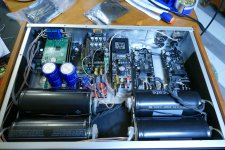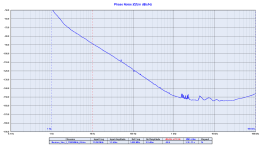Cheval from Amazon. The top, bottom panels may be not thick enough for someone. Check the pic. I prefer thicker, but this one cheap.What brand? Link?
Thx.
The size of Neutron Star or other similar ones are too large, and the clock signal must be input through the signal wire. The signal wire itself will generate a huge amount of clock jitter, which greatly reduces the quality of the clock signal.I´m so curious,so i hardly can not wait to compare to mine Neutron Star NS3 Clocks same frequencys. Driven by double 16v Maxvell Ultracapacitor stacks in pure mode.
If the price of SC-Pure is compared with that of Neutron Star, which has almost no sales, the sales of SC-Pure may be miserable. If SC-Pure's sales strategy is to gradually reduce the price, when the first group of fans buy it, the price of SC-Pure will drop sharply, which will only consume Ian's brand. In a bad economic environment, small profits are the only way to sell more. In addition, there are fewer and fewer people who are still playing audio modules, because listening to music with mobile phones can get quite good sound quality.@Batenet
Just hope it won't make you wait too long.
I have a Neutron Star2 45.xxxMHz myself. It's a really great clock. I like the sound signature, very musical and with dark background. But what surprised me is that it doesn't use SC-CUT crystal. My Neutron Star could use a customized fundamental AT-CUT crystal (also not the 3rd or 5rd overtone crystal). It must be an art of work to make the non SC-CUT crystals sound that good.
Another thing surprised me is that Neutron Star is not an OCXO. It does have heat element on the PCB, but the turnover temperature is only around 40 degree(C). I think it's just for making the temperature stable against the changing of the ambient temperature.
Neutron Star didn't post any phase noise measurement results or numbers. It must be a magic product. I'm really curious how the designer makes it? The only problem is that the high-end Neutron Star clocks are too expensive. I don't think SC-Pure can reach that price levels.
It is difficult for us to know the real sales volume of Neutron Star, but we can speculate based on the browsing data of the website. Newclassd.com has many items of browsing data that cannot be analyzed, which means that the website traffic is too low. In contrast, audiophonics.fr can analyze various data.
https://www.similarweb.com/website/newclassd.com
https://www.similarweb.com/website/audiophonics.fr/
Show proof to support this concern, please …….The signal wire itself will generate a huge amount of clock jitter, which greatly reduces the quality of the clock signal.
The person you are thinking has a banned account with their last forum activity on July 9th, 2021. MVP's account started on July 15th, 2021. I'm sure it is just a coincidence. Now, please do me the favor of looking directly into the eyes of my avatar while repeating "I'm sure it's just a coincidence."You sound familiar?
You should understand a very basic concept: the longer the transmission path, the greater the probability and degree of electromagnetic wave interference, even if the transmission wire is well done, so the clock signal passing through the signal wire will naturally be subject to additional electromagnetic wave interference , the jitter brought by the wire, need to feel very surprised?Show proof to support this concern, please …
This is because electromagnetic waves can undergo interference, which is a phenomenon where two or more waves meet and produce a stronger or weaker effect depending on their phase difference. If the width of the transmission line is close to the wavelength of the electromagnetic wave, then diffraction will occur, which is a phenomenon where electromagnetic waves bend or spread around the edges of obstacles. These phenomena can affect the signal quality and stability on the transmission line, so some measures need to be taken to reduce electromagnetic wave interference, such as using shielded wires, increasing signal strength, changing signal frequency, etc. However, any means of dealing with electromagnetic waves can be only reduced the impact of electromagnetic waves.
It is good to avoid them, why make trouble for yourself. In other words, just buy a good quality clock that plugs directly into the clock socket.
For example, pulsar clock or maybe SC-Pure. I believe that the level of SC-Pure can be at least comparable to pulsar clock, otherwise Ian would not need to invest resources to make SC-Pure.
Ian just can't tell the truth I'm telling you, you should accept it.
So, you don’t need to be surprised, this is a common phenomenon in physics. You can refer to the following sources to learn more about electromagnetic wave interference and transmission path:
: 17.1 Understanding Diffraction and Interference - Physics | OpenStax
Last edited:
You sound familiar too?You sound familiar?
I have reported you for trying to start a fight, you should stop.The person you are thinking has a banned account with their last forum activity on July 9th, 2021. MVP's account started on July 15th, 2021. I'm sure it is just a coincidence. Now, please do me the favor of looking directly into the eyes of my avatar while repeating "I'm sure it's just a coincidence."
So when you test clocks, usually by connecting a cable(wire) to an instrument all readings will be wrong?You should understand a very basic concept: the longer the transmission path, the greater the probability and degree of electromagnetic wave interference, even if the transmission wire is well done, so the clock signal passing through the signal wire will naturally be subject to additional electromagnetic wave interference , the jitter brought by the wire, need to feel very surprised?
…..
And a review of a wired clock
I have a Neutron Star2 45.xxxMHz myself. It's a really great clock. I like the sound signature, very musical and with dark background. But what surprised me is that it doesn't use SC-CUT crystal. My Neutron Star could use a customized fundamental AT-CUT crystal (also not the 3rd or 5rd overtone crystal). It must be an art of work to make the non SC-CUT crystals sound that good.
Of course shorter is better,I trye to have as short as possible.Take a look my picture,have 4 inch to sinepi from clocks.You should understand a very basic concept: the longer the transmission path, the greater the probability and degree of electromagnetic wave interference, even if the transmission wire is well done, so the clock signal passing through the signal wire will naturally be subject to additional electromagnetic wave interference , the jitter brought by the wire, need to feel very surprised?
This is because electromagnetic waves can undergo interference, which is a phenomenon where two or more waves meet and produce a stronger or weaker effect depending on their phase difference. If the width of the transmission line is close to the wavelength of the electromagnetic wave, then diffraction will occur, which is a phenomenon where electromagnetic waves bend or spread around the edges of obstacles. These phenomena can affect the signal quality and stability on the transmission line, so some measures need to be taken to reduce electromagnetic wave interference, such as using shielded wires, increasing signal strength, changing signal frequency, etc. However, any means of dealing with electromagnetic waves can be only reduced the impact of electromagnetic waves.
It is good to avoid them, why make trouble for yourself. In other words, just buy a good quality clock that plugs directly into the clock socket.
For example, pulsar clock or maybe SC-Pure. I believe that the level of SC-Pure can be at least comparable to pulsar clock, otherwise Ian would not need to invest resources to make SC-Pure.
Ian just can't tell the truth I'm telling you, you should accept it.
So, you don’t need to be surprised, this is a common phenomenon in physics. You can refer to the following sources to learn more about electromagnetic wave interference and transmission path:
: 17.1 Understanding Diffraction and Interference - Physics | OpenStax
Attachments
Don't know about Neutron Star 45Mhz. However, just received a phase noise plot for a Neutron Star 3, 11.xxx Mhz version:...have a Neutron Star2 45.xxxMHz...
Attachments
For about 1$ similar performance at 50MHz.It s not terrible for à fréquency of 11Mhz.
https://www.mouser.fi/datasheet/2/122/ECS_2520MVLC-1903379.pdf
- Home
- Source & Line
- Digital Line Level
- Asynchronous I2S FIFO project, an ultimate weapon to fight the jitter

